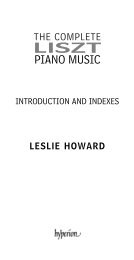CHORAL MUSIC BY JONATHAN DOVE - Abeille Musique
CHORAL MUSIC BY JONATHAN DOVE - Abeille Musique
CHORAL MUSIC BY JONATHAN DOVE - Abeille Musique
Create successful ePaper yourself
Turn your PDF publications into a flip-book with our unique Google optimized e-Paper software.
illiantly throws the music into D flat major, from an A<br />
major tonality, after which the movement dances to a<br />
brilliant ending. The Sanctus & Benedictus carries on the<br />
dance in a ‘spirited’ setting. There are some similarities<br />
with Britten’s Missa brevis in the way the organ chords<br />
build up before the choral entry. However, where Britten<br />
leads straight into bell-like writing, Dove begins with a<br />
chordal outburst for the word ‘Sanctus’ and reserves his<br />
bell-like choral writing for the words ‘Dominus Deus<br />
Sabaoth’. The Hosanna at the end brings back the opening<br />
chords of the movement. The Agnus Dei is formed over an<br />
organ pedal point with a held low E and A which moves<br />
only twice during the movement, cleverly ratcheting up the<br />
tension with minimal fuss but maximum effect. After six<br />
bars of organ introduction (a short figure played by the<br />
right hand prepares us for the choral entry) the choir sings<br />
short chordal phrases. The introductory organ material<br />
is reduced to four bars for the next choral entry and the<br />
first pedal point move. After this the organ’s material is<br />
reduced further to two bars and the climactic pedal point<br />
shift to C and G with the choir singing the final ‘Agnus Dei’<br />
strongly before subsiding into a mantra-like repetition of<br />
the words ‘dona nobis pacem’. It is a most beautiful and<br />
effective movement.<br />
One of the methods of development used by contemporary<br />
‘minimalists’ is the use of a motif which is then<br />
repeated again and again with a ‘binding’ feature such<br />
as a melody leading it into different pitches and tonal<br />
areas. Contrast in these pieces is usually provided by the<br />
introduction of a different repeated motif in another mood<br />
and dynamic. This is the pattern for I am the day, an<br />
unaccompanied work setting a brief Advent text from<br />
Revelation chapter 22 describing the promise of the<br />
coming of Jesus. It was a Spitalfields Festival commission,<br />
first performed in December 1999 by the choir of Trinity<br />
College, Cambridge. The key elements are the stillness of<br />
3<br />
the opening bars, marked to be sung ‘with mystery’, and<br />
the following scherzo-like music which is ‘dancing and<br />
playful’. The second section maintains the melodic<br />
element of the first section sung by the basses while the<br />
upper voices sing short phrases taken from the Advent<br />
hymn O come, O come Emmanuel. This is highly effective<br />
as it acts almost like a distant memory of the hymn—<br />
something in the mind which one is trying to remember<br />
but, like a folk song learned in the cradle, the whole<br />
melody refuses to yield itself fully. The two contrasting<br />
elements return before a reflective ending has the trebles<br />
and altos gently wafting skywards like rising incense.<br />
Wellcome, all wonders in one sight! was written for<br />
South Wilts A Cappella (a choir from South Wilts Grammar<br />
School) to sing in Salisbury Cathedral. It is an unaccompanied<br />
setting of a section of an extended poem<br />
called ‘An Hymne of the Nativity, sung as by the shepherds’<br />
by the seventeenth-century metaphysical poet Richard<br />
Crashaw. This poem has a chorus of shepherds who<br />
encourage the two principal characters (also shepherds),<br />
Tityrus and Thyrsis, to tell what they saw at Christ’s birth.<br />
Dove uses a very small section of the chorus and part of<br />
a verse when both Tityrus and Thyrsis speak together<br />
(‘We saw thee in thy balmy nest’). Dove has written of<br />
Crashaw’s paradoxical imagery which spoke strongly to<br />
him: ‘Eternity shut up in a span. Summer in winter, day<br />
in night’, which, with remarkable economy, conveys the<br />
power of this miraculous event.<br />
Dove’s setting uses the constant repetition of the words<br />
‘wellcome wonder’ as an accompanimental motif which<br />
rocks like the cradle and perhaps also suggests the hushed<br />
awe of the shepherds. Around this, first the trebles, then<br />
the first basses, and later still the tenors, sing the full text<br />
in beautifully lyrical lines which Dove instructs to be sung<br />
‘with awe’. Coming to the end of the first section, which<br />
returns in the middle and near the end, Dove produces a
















